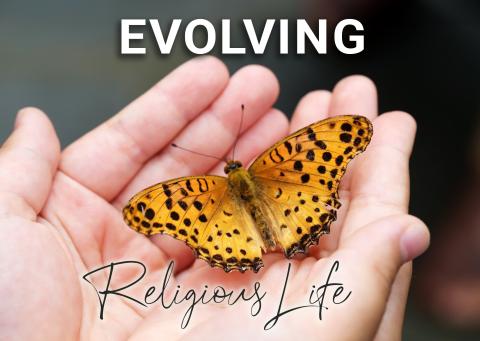Sr. Madeleine is one of eight Missionary Sisters of the Gospel, ages 79 to 98, who live at Chêne de Mambré, a béguinage in Angers, France. Based on a medieval European tradition, the béguinage houses older religious sisters and laypeople who are independent. (GSR photo/Elisabeth Auvillain)
Editor's note: "Evolving Religious Life," a new series from Global Sisters Report, is exploring how Catholic sisters are adapting to the realities of congregations in transition and new forms of religious life. While we write often about these trends, this particular series will focus more closely on sisters' hopes for the future.

Elderly sisters here built a place to live with older laypeople, pursuing their mission of welcoming and caring for others, reviving the béguinage, a medieval European tradition.
Small houses built around a square garden full of flowers in 2015 today constitute the Chêne de Mambré in Angers, a small town in western France near the Loire Valley. On one side of the structure are the rooms of eight elderly Missionary Sisters of the Gospel. The other side of the two-story building houses residents of the béguinage, older people who are strong and independent enough not to enter a retirement home.
The idea of a béguinage started more than 10 years ago when four communities decided to form a new congregation, the Missionary Sisters of the Gospel. Two communities were in Angers, where they mainly ministered in hospitals and schools. The others, in Caen, in Normandy, and Nantes, in Brittany, looked after the elderly.
Each community was experiencing declining numbers, and it was time to think of the future and find a place where they could continue their mission and welcome older people ready to share their values while leading independent lives. This future included laypeople.
"We could be a presence close to laypeople living in the béguinage. They are welcome to our morning prayers (laudes) and evening prayer (vespers)," one sister told GSR.
The sisters pursue their vision
Eight sisters now live at Chêne de Mambré. The youngest is 79, the oldest 98. Each has her own room. They share meals, taking turns preparing them, and going to the oratory for prayers twice daily.
"We are still independent, able to take care of ourselves, [and] so are the residents, whose homes include a kitchen to cook their meals. They can also call a delivery service. This independence is a condition to being admitted in the béguinage," said Sr. Marie Jeanne, who leads the community.
"We are now too old to keep doing activities in town on a regular basis like we used to: religious education or health care," she said. "In the béguinage, we are always ready to talk to the residents if they would like to have a conversation with somebody. This is a way for us to pursue our mission. When we get older and dependent, we move to the old people's home nearby."
Magnificent trees have grown in the park between the laypeople's and sisters' living spaces. One tree, an oak several centuries old, is particularly beautiful. The sisters chose the name "Chêne de Mambré" (oak tree of Mambré), a reference to the Genesis story where the Lord came to talk to Abraham, for the béguinage.
Twenty-six residents ages 70 to 100 years — including two couples, two priests, widows and widowers, and a few single people — live in the béguinage. Like most in the region, the home has strict rules and only accepts very independent guests. Some like to talk to their neighbors, and others value their privacy. But all take part in the monthly gatherings. José, one resident, takes pictures, which he puts in a book everyone is happy to enjoy in the community room. Françoise takes care of the garden. Marie-Nolle talks about going to a movie in town with another resident.

Elderly sisters and laypeople live at Chêne de Mambré, a béguinage in Angers, France. Missionary Sisters of the Gospel created the béguinage to continue their mission of welcoming and caring for one another. (GSR photo/Elisabeth Auvillain)
"We receive visits from people and groups who have a project to welcome seniors and who come to discover what is happening here; they see the interest of living in a béguinage," Sr. Marie-Jeanne said.
The nuns hold community meetings every Saturday and participate in recollections and retreats. Some are still involved in neighborhood associations. Sr. Madeleine, who likes to knit, sews together granny squares made by members of a knitting group in town. "I can't walk anymore to the place where the group meets; it is too far. So I work from here," she told GSR, sitting in a comfortable chair by a window.
Other sisters pray the rosary with a group of parishioners.
"Today, women from different cultures, backgrounds and ages, we let us welcome each other as a gift to constitute a community which participates in the mission of Christ," the constitution of the Missionary Sisters of the Gospel states.
Choosing who can live at the béguinage is challenging. Accommodation is cheaper than in town, the buildings are part of the town's rent-controlled program, and many people and their families are interested.
The sisters are careful: They created a charter to explain life in the béguinage. It requires goodwill from its inhabitants and a readiness to participate in monthly meetings and other festivities. Older people interested in living there must read and agree with the charter.
"One of the main features of life together will show mainly through solidarity, through the attention we show toward aging and health issues of everyone that one of the main features of life together will show," the 10-page text says in its introduction. "To choose to live in a béguinage is to decide to be close to the others while respecting their freedom."
Residents of Chêne de Mambré take an afternoon walk. The Angers, France, béguinage is run by the Missionary Sisters of the Gospel. Eight sisters live there. (GSR photo/Elisabeth Auvillain)
St. Martin béguinage
Angers is home to another béguinage created by sisters. Three Sisters of the Retreat live there, and another will join them in the fall.
The Sisters of the Retreat follow the exercises of St. Ignatius and were founded in 1675 in Brittany (France). In 1880, some went to England and founded a convent in Clapham Park. More followed in other parts of England. Like every congregation, their numbers are declining.
The founders of St. Martin had hoped to set up a community mixing generations. They allowed four students to live there. Only one took the idea of living in a béguinage seriously, they said. The others do not participate in the life and activities of the béguinage.
"We are still working on our charter, where we will be more precise about what we expect from everyone at St. Martin's," explained Sr. Anne-Marie, who leads the community.
Most residents heard about the béguinage through church activities. They are happy to live there, even though, as Marguerite, a resident, said, "It can be very quiet during the weekends." She is lucky, though: her son lives nearby and visits often.
A tradition from the Middle Ages
Béguinages were born in the Middle Ages in Flanders, a European province that included what is now a part of Northern France, Belgium and the Netherlands. At that time, some pious widows decided to live together in a community where each would have her own lodgings and some autonomy. They would meet for prayers every day. The living arrangement allowed them to avoid being forced to remarry or to live in a convent, both cases meaning under the rule of men.
According to the sisters, their Angers project also takes root in the founding intuition of the congregation, which always sought to respond to the challenges of society: In the 17th century, it was poverty and ignorance. Over the centuries, numerous adaptations and new creations were experienced. Today, their concern is to fight against individualism and to experience solidarity with the most vulnerable.
"We favor a habitat open to a neighborhood close to health services, shops and markets, served by public transport in the heart of a parish," said Sr. Eliane Loiseau, who recently retired as mother superior of the Missionary Sisters of the Gospel.
Is there a good age to join the béguinage? It depends on the person's health. The question remains open, the sisters said.
Advertisement
Many people have shown interest in such housing options in a country where the population is aging. More than 20% of France's population are older than 65, and 10% are older than 75, a trend expected to continue for the next 15 years.
Land management companies, which have witnessed the success of these dwellings, are now developing similar housing, mainly in western France. They do not talk about a spiritual community, but stress how older people can live with others and not feel too isolated. Some new projects have been built, for example, highlighting the need for a safe place for older people with mobility issues.
"We receive visits from people and groups who have a project to welcome seniors and who come to discover what is happening here," Sr. Marie-Jeanne said






